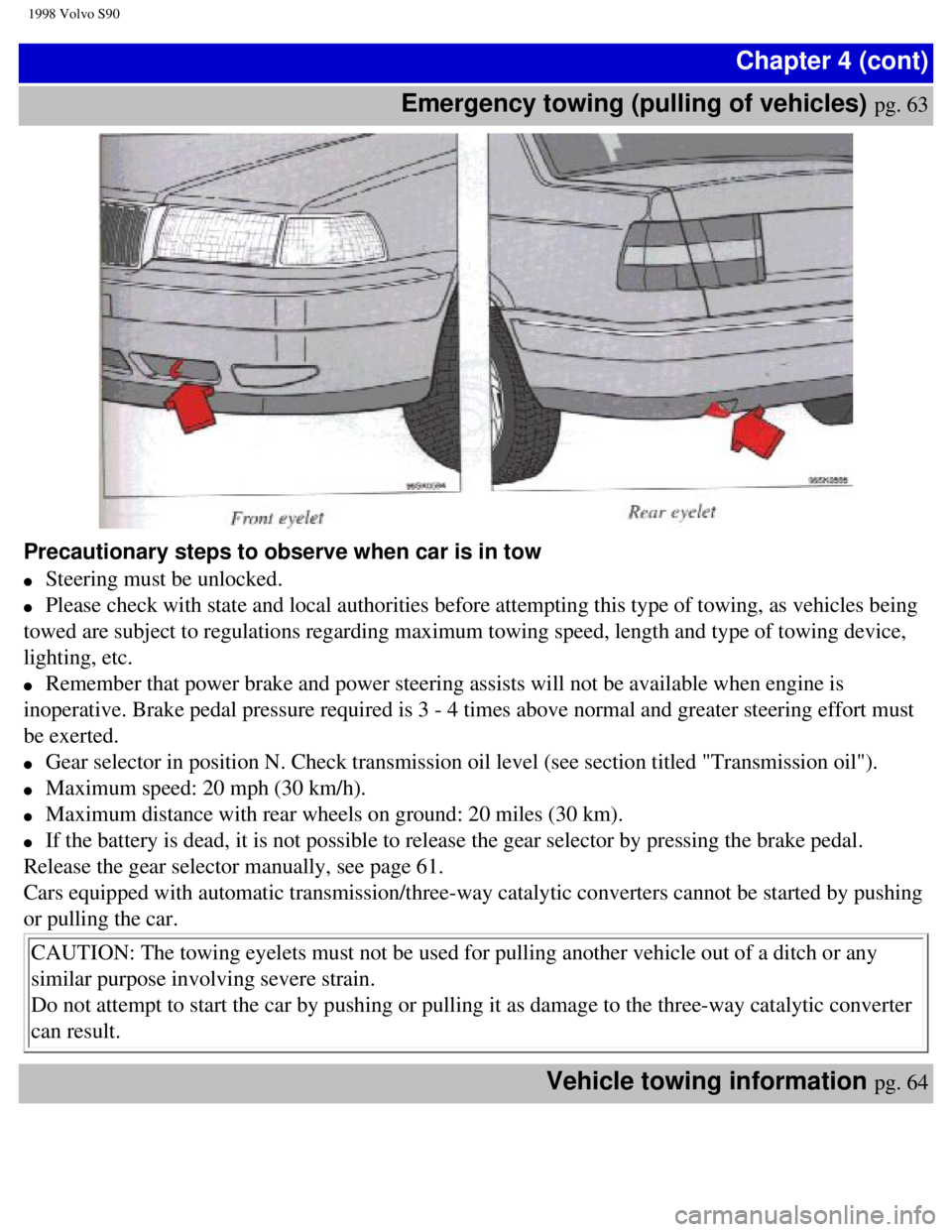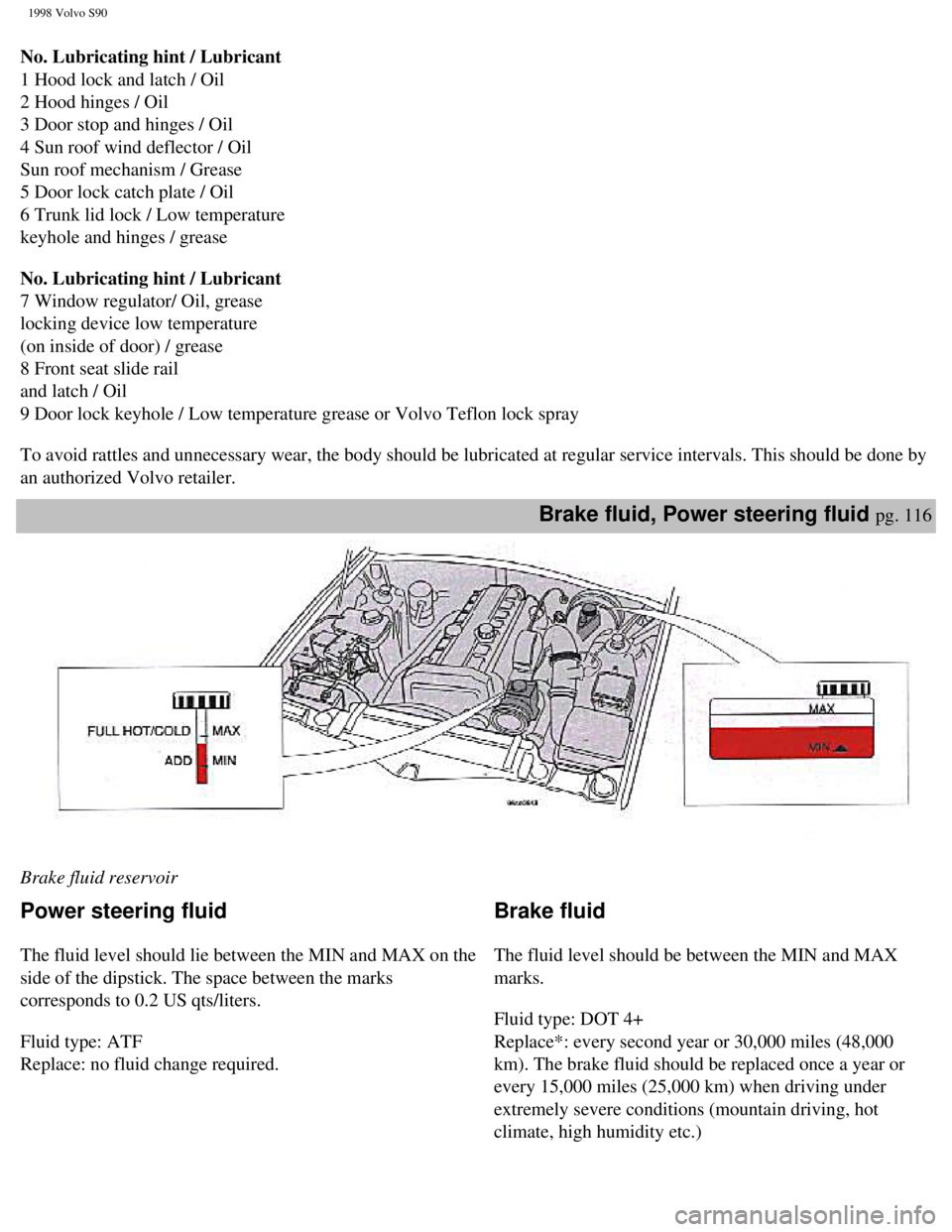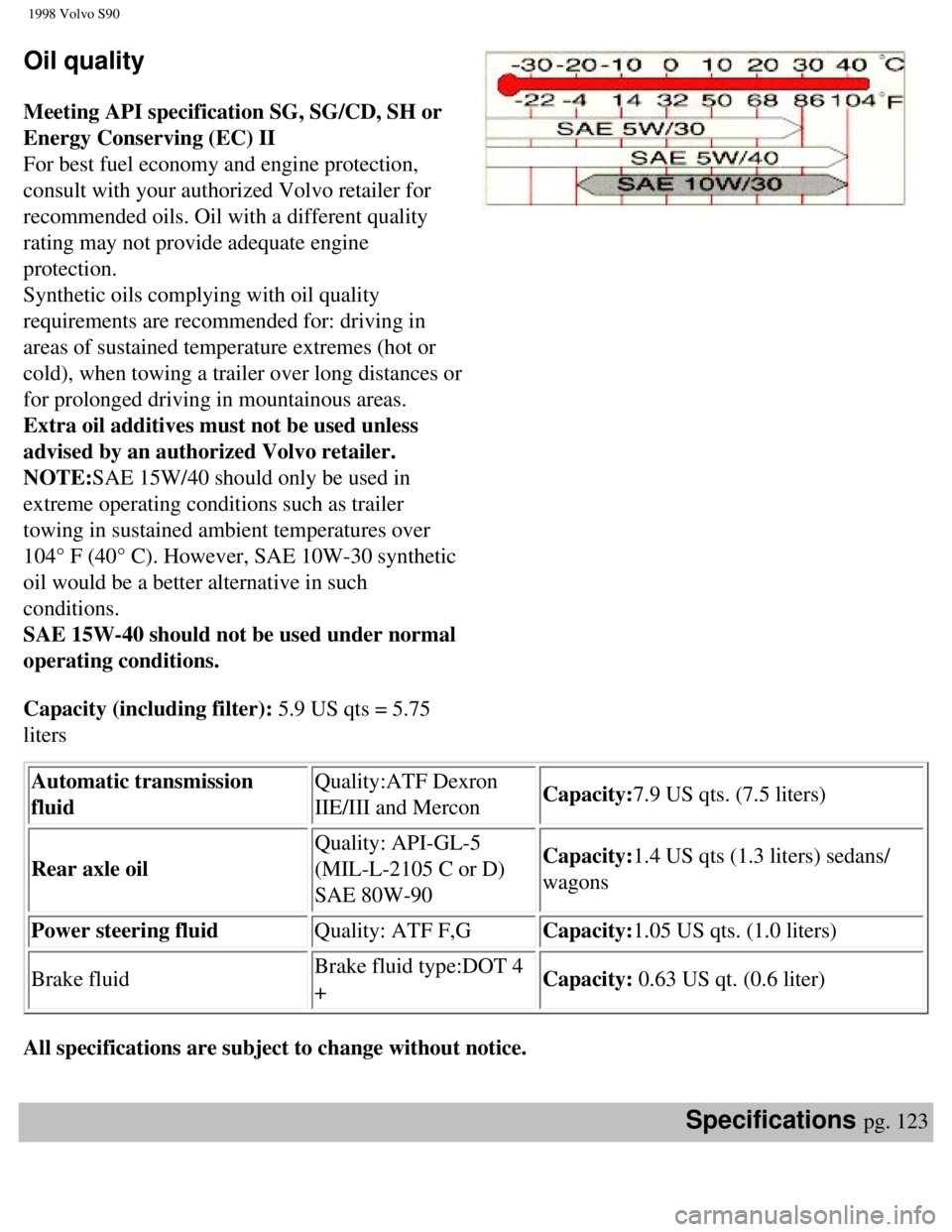1998 VOLVO V90 oil type
[x] Cancel search: oil typePage 35 of 175

1998 Volvo S90
lock, the cruise control will
disengage automatically.
Heating, ventilation and air conditioning pg. 25
ECC - Electronic Climate Control
This is an automatic system that also permits
manual operation. The in-car temperature is
automatically monitored by two sensors located in
the passenger compartment.
One sensor is located on the top of the dashboard
where it can sense sunlight. The second sensor is
located on the courtesy light fixture where it can
sense the temperature in the center of the car. The
following pages describe how ECC works and
how it can be used most effectively.
Refrigerant
Volvo cares about the environment. The air
conditioning system in your car contains a CFC-
free refrigerant - R134a. This substance will not
deplete the ozone layer. The system contains 2 lbs
(0.9 kg) R134a and uses Sanden SP-20 (type
PAG) oil.
Air vents (dash)
A Open
B Closed
C Directing air flow horizontally
D Directing air flow vertically
NOTE:All maintenance on the climate control
systems should be carried out by an authorized
Volvo service technician only.
Heating, ventilation and air conditioning (cont.) pg. 26
file:///K|/ownersdocs/1998/1998_SV90/98S90_023.htm (4 of 7)12/30/2006 \
1:52:37 PM
Page 73 of 175

1998 Volvo S90
Chapter 4 (cont)
Emergency towing (pulling of vehicles)
pg. 63
Precautionary steps to observe when car is in tow
l Steering must be unlocked.
l Please check with state and local authorities before attempting this typ\
e of towing, as vehicles being
towed are subject to regulations regarding maximum towing speed, length \
and type of towing device,
lighting, etc.
l Remember that power brake and power steering assists will not be availab\
le when engine is
inoperative. Brake pedal pressure required is 3 - 4 times above normal a\
nd greater steering effort must
be exerted.
l Gear selector in position N. Check transmission oil level (see section \
titled "Transmission oil").
l Maximum speed: 20 mph (30 km/h).
l Maximum distance with rear wheels on ground: 20 miles (30 km).
l If the battery is dead, it is not possible to release the gear selector \
by pressing the brake pedal.
Release the gear selector manually, see page 61.
Cars equipped with automatic transmission/three-way catalytic converters\
cannot be started by pushing
or pulling the car.
CAUTION: The towing eyelets must not be used for pulling another vehicle\
out of a ditch or any
similar purpose involving severe strain.
Do not attempt to start the car by pushing or pulling it as damage to th\
e three-way catalytic converter
can result.
Vehicle towing information pg. 64
file:///K|/ownersdocs/1998/1998_SV90/98S90_063.htm (1 of 4)12/30/2006 \
1:52:43 PM
Page 79 of 175

1998 Volvo S90
Observe legal requirements of
the state in which the vehicles
are registered.
WARNING! Bumper-
attached trailer hitches must
not be used on Volvos, nor
should safety chains be
attached to the bumper.
Trailer hitches attaching to
the vehicle rear axle must
not be used. kgs) a top speed of 50 mph (80
km/h) should never be
exceeded.
l Increase tire pressure to
recommended full-load
pressure. See section "Wheels
and tires".
l Engine and transmission are
subject to increased loads.
Therefore, engine coolant
temperature should be closely
watched when driving in hot
climates or hilly terrain. Use
lower gear and turn off air
conditioner if temperature gauge
pointer enters the red range.
towing a trailer to ensure that the
max. permissible axle load or
gross vehicle weight are not
exceeded.
NOTE: Refer to section
"Automatic transmission" for
additional trailer hauling tips.
Winter driving pg. 69
Cold weather precautions
l If you wish to check your car before the
approach of cold weather, the following advice is
worth noting:
Make sure that the engine coolant contains at least
50 percent antifreeze: that is, 5.3 qts. (5 liters)
Volvo Genuine Coolant/Antifreeze. This gives
protection against freezing down to -31°F (-35°
C). See section "Coolant".
The use of "recycled" antifreeze is not approved
by Volvo. Different types of antifreeze may not be
mixed.
l Try to keep the fuel tank well filled - this
prevents the formation of condensation in the
tank.
In addition in extremely cold weather conditions it
is worthwhile to add fuel line de-icer before
refueling.
l The viscosity of the engine oil is important. Oil
with low viscosity (thinner oil) improves cold-
weather starting as well as decreasing fuel
consumption while the engine is warming up. For
winter use, 5W-30 oil, particularly the synthetic
type, is recommended.
Be sure to use good quality oil but do not use this
l The Volvo Washer Solvent should be diluted as
follows:
Down to 14°F (-10°C): 1 part anti-freeze and 4
parts water
Down to 5°F (-15°C): 1 part anti-freeze and 3
parts water
Down to 0°F (-18°C): 1 part anti-freeze and 2
parts water
Down to -18°F (-28°): 1 part anti-freeze and 1
part water
l Use lock spray or grease in the locks.
NOTE: Avoid the use of de-icing spray as they
can cause damage to the locks.
Automatic differential lock (certain
models)
The differential automatically locks at speed
between 3 - 25 mph (5 - 40 km/h) if either of the
drive wheels begins to lose traction. The
differential lock improves power distribution to
the drive wheels in slippery conditions, shifting
power to the wheel with best traction. It also
file:///K|/ownersdocs/1998/1998_SV90/98S90_067.htm (3 of 5)12/30/2006 \
1:52:43 PM
Page 91 of 175

1998 Volvo S90
Chapter 6 - (cont.)
Replacing bulbs
pg. 81
Replacing bulbs
The method for replacement of bulbs in
the various lighting units is shown on the
following pages. Make sure when
installing bulbs, that the guide pin on the
socket fits into its corresponding recess.
When installing Halogen bulbs, do not
touch the glass with your fingers because
grease, oil or any other impurities can be
carbonized onto the bulb and damage the
reflector.
Use bulbs of correct type and voltage.
Failure to do so could cause the bulb
failure warning light to activate.
NOTE: Turn the ignition and light
switch off before replacing any bulbs.
Headlights (high/low beams)
1. Press the protruding tabs on the plastic
cover and pull out towards the fender.
2. Turn the bulb and connector 1/4 turn
counterclockwise and remove.
3. Remove the connector from the bulb.
4. Press a new bulb into the connector
without touching the bulb itself.
5. Reinsert the bulb into the headlight
housing and turn 1/4 turn clockwise until
the unit seats properly.
6. Reinstall the plastic cover.
Bulb Power US Bulb No.
High beam 70W HB3/9005
Low beam 60W HB4/9006
Headlight adjustment
The height of the headlight beams can be
adjusted according to vehicle load. The
headlights should be re-aimed if heavy
loads are carried in the trunk/cargo area or
rear seat, or when towing a trailer.
To adjust the headlights:
Park the car on a level surface and open
the hood.
The headlights are equipped with a level
which can be seen by looking through the
clear "window" on the top of the headlight
lens.
Turn the height adjustment knob (A) until
the bubble in the level aligns with within
the marking lines on the level.
Lateral headlight adjustment (B) should
only be carried out by an authorized
Volvo retailer. This setting should be
preset to "0".
Replacing bulbs pg. 82
file:///K|/ownersdocs/1998/1998_SV90/98S90_081.htm (1 of 6)12/30/2006 \
1:52:45 PM
Page 121 of 175

1998 Volvo S90
extreme operating conditions such as trailer
towing in sustained ambient temperatures over
104° F (40° C). However, SAE 10W-30 synthetic
oil would be a better alternative in such
conditions.
SAE 15W-40 should not be used under normal
operating conditions.
American Petroleum Institute
(API) labels. These labels certify
the oil conforms to the applicable
standards and specifications of
the API.
Servicing pg. 110
Torque exhaust and
intake manifold nuts
A loose manifold could alter air/
fuel ratio and cause an increase
in emissions and/or poor
driveability.
Air cleaner
Replace the air cleaner cartridge
with a new one every 30,000
miles (48,000 km). The
cartridge should be replaced
more often when driving under
dirty and dusty conditions, The
filter cannot be cleaned and,
therefore, should always be
replaced with a new one.
Vacuum fittings, hoses
and connections
Unstable idle, misfiring, or poor
emission control is often caused
by leaking vacuum hoses or
connections. Check hoses and
connections on distributor
vacuum unit, connections on
heater control servo systems and
hydraulic brake servo.
Fuel system cap, tank
and lines, and
connections
The effectiveness of the fuel
system to contain hydrocarbons
is dependent largely on a
leakfree system. Check for
proper sealing of gasoline filler
cap which contains "O" ring-
type seals. Check all
evaporative hoses in vehicle for
tightness. Check fuel lines under
vehicle and repair if necessary.
Fuel (line) filter
The fuel line filter is located
next to the fuel pump. This filter
should be replaced every
100,000 miles (160,000 km).
The filter is replaced as one
complete unit.
Replace more frequently if
contaminated fuel is introduced
into the tank (or if there is
reason to suspect that this has
occurred).
Timing belt
WARNING!
The distributor ignition
system operates at very high
voltages. Special safety
precautions must be followed
to prevent injury.
Always turn the ignition off
when:
l Replacing distributor
ignition components e.g.
plugs, coil, etc.
l Do not touch any part of
the distributor ignition system
while the engine is running.
This may result in unintended
movements and body injury.
Replacing spark plugs
The spark plugs should be
changed every 30,000 miles
(48,000 km). However, city
driving or fast highway driving
may necessitate changing after
15,000 miles (24,000 km) of
driving. When installing new
plugs, be sure to fit the right type
file:///K|/ownersdocs/1998/1998_SV90/98S90_108.htm (3 of 6)12/30/2006 \
1:52:49 PM
Page 126 of 175

1998 Volvo S90
No. Lubricating hint / Lubricant
1 Hood lock and latch / Oil
2 Hood hinges / Oil
3 Door stop and hinges / Oil
4 Sun roof wind deflector / Oil
Sun roof mechanism / Grease
5 Door lock catch plate / Oil
6 Trunk lid lock / Low temperature
keyhole and hinges / grease
No. Lubricating hint / Lubricant
7 Window regulator/ Oil, grease
locking device low temperature
(on inside of door) / grease
8 Front seat slide rail
and latch / Oil
9 Door lock keyhole / Low temperature grease or Volvo Teflon lock spray \
To avoid rattles and unnecessary wear, the body should be lubricated at \
regular service intervals. This should be done by
an authorized Volvo retailer.
Brake fluid, Power steering fluid pg. 116
Brake fluid reservoir
Power steering fluid
The fluid level should lie between the MIN and MAX on the
side of the dipstick. The space between the marks
corresponds to 0.2 US qts/liters.
Fluid type: ATF
Replace: no fluid change required.Brake fluid
The fluid level should be between the MIN and MAX
marks.
Fluid type: DOT 4+
Replace*: every second year or 30,000 miles (48,000
km). The brake fluid should be replaced once a year or
every 15,000 miles (25,000 km) when driving under
extremely severe conditions (mountain driving, hot
climate, high humidity etc.)
file:///K|/ownersdocs/1998/1998_SV90/98S90_114.htm (2 of 5)12/30/2006 \
1:52:50 PM
Page 131 of 175

1998 Volvo S90
Oil quality
Meeting API specification SG, SG/CD, SH or
Energy Conserving (EC) II
For best fuel economy and engine protection,
consult with your authorized Volvo retailer for
recommended oils. Oil with a different quality
rating may not provide adequate engine
protection.
Synthetic oils complying with oil quality
requirements are recommended for: driving in
areas of sustained temperature extremes (hot or
cold), when towing a trailer over long distances or
for prolonged driving in mountainous areas.
Extra oil additives must not be used unless
advised by an authorized Volvo retailer.
NOTE:SAE 15W/40 should only be used in
extreme operating conditions such as trailer
towing in sustained ambient temperatures over
104° F (40° C). However, SAE 10W-30 synthetic
oil would be a better alternative in such
conditions.
SAE 15W-40 should not be used under normal
operating conditions.
Capacity (including filter): 5.9 US qts = 5.75
liters
Automatic transmission
fluid Quality:ATF Dexron
IIE/III and Mercon
Capacity:7.9 US qts. (7.5 liters)
Rear axle oil Quality: API-GL-5
(MIL-L-2105 C or D)
SAE 80W-90Capacity:1.4 US qts (1.3 liters) sedans/
wagons
Power steering fluid Quality: ATF F,GCapacity:1.05 US qts. (1.0 liters)
Brake fluid Brake fluid type:DOT 4
+Capacity: 0.63 US qt. (0.6 liter)
All specifications are subject to change without notice.
Specifications pg. 123
file:///K|/ownersdocs/1998/1998_SV90/98S90_121.htm (2 of 4)12/30/2006 \
1:52:50 PM
Page 132 of 175

1998 Volvo S90
Engine
Liquid-cooled, gasoline, 6-
cylinder, in-line engine.
Aluminum alloy cylinder
block with cast-iron cylinder
liners cast directly into block.
Aluminum alloy cylinder head
with double overhead
camshafts and separate intake
and outlet channels.
Engine lubrication is provided
by an eccentric pump driven
from the crankshaft. Full-flow
type oil filter. Exhaust
emission control
accomplished by fuel
injection, heated oxygen
sensors and three-way
catalytic converter.
Type designation
Output (SAE J 1349)
Max. torque (SAE J 1349) at
rpm
Number of cylinders
Bore
Stroke
Displacement
Compression ratio
Valve clearance:Volvo B 6304 S
181 hp at 5200 rpm
(135 kW at 73 rps)
199 ft. lbs. (274 Nm) at 4100
rpm
6
3.27" (83 mm)
3.54" (90 mm)
2.92 liters
10.7:1
Self-adjusting
All specifications are subject
to change without notice.
Specifications (cont.) pg. 124
file:///K|/ownersdocs/1998/1998_SV90/98S90_121.htm (3 of 4)12/30/2006 \
1:52:50 PM